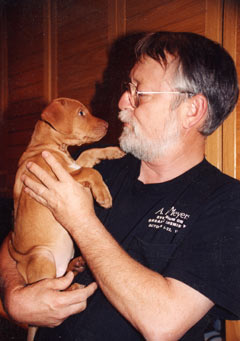Professor and his dogs have the right chemistry
Clayton Heathcock escapes rigors of academia by breeding, showing ‘Ridgies’
![]()
| 12 February 2003
| |  Heathcock — in the throes of puppy love — snuggles with the newest addition to his pack of prize-winning Rhodesian Ridgebacks. |
As dean of the College of Chemistry, Clayton Heathcock has many constituents vying for his time — faculty, students, staff, administrators, and alumni among them. Things aren’t much different at home, where eight 80-pound Rhodesian Ridgeback dogs anxiously await his arrival every evening.
“Unlike the people at work, though, all these dogs want is love, a little exercise, and some food,” Heathcock jokes. “And except for the occasional bark, they don’t talk back!”
The hounds are more than just beloved pets for Heathcock (pronounced HETH-cock) and his wife, College of Chemistry administrator Cheri Hadley. Several of them are also award-winning show dogs. Why, one might ask, would an internationally recognized scientist ensconced in the rarefied world of high-level academia take up dog breeding and showing?
“It keeps me sane,” he explains. “It’s refreshing to get away from the high-pressure atmosphere of running a chemistry college and just hang out with fellow dog lovers.”
Heathcock often spends his weekends travelling to competitions throughout the country. Occasional-ly, he shows the dogs himself, prancing around the arena with one of his beloved “Ridgies,” trying to impress the judges. But more often, he hands the leash over to professional handlers. Over the years, several of his dogs have received championship designations.
A life-long animal lover, Heathcock has owned many dogs since childhood, mostly mutts. His passion for Rhodesian Ridgebacks — a South African breed developed during the 18th century when European settlers crossed their dogs with those of the indigenous Hottentot tribes — started after the death of the family dog more than 15 years ago.
“After a year of grieving, we finally decided to get another dog,” Heathcock recalls. “This time around, we decided to take a more methodical approach to selecting a breed.”
He and his wife made a list of criteria. They wanted their dog to be large, so either would feel safe if alone in the house; a purebred that required no modifications (such as ear cropping or tail docking); short-haired, with minimal shedding; and mellow, so it wouldn’t bounce off the walls while Heathcock and his wife are at work.
Next, the couple went to the Golden Gate Kennel Club dog show at the Cow Palace to look over the various breeds and see which one most closely matched their desires.
“We were intrigued by the Mastiff and Bloodhound, but both slobbered too much,” he says. “The Ridgeback was a perfect fit.”
They bought a puppy from a couple in Santa Cruz, a female they named Morganna. The dog was a great specimen, and the breeders convinced Heathcock to try showing her.
“She got a championship within a few months,” he says. “It seemed so easy, I thought I’d try it again, so I got another Ridgeback.”
Heathcock has since gone to the dogs. He started an official kennel, called “Camelot,” 13 years ago, and was president of the Rhodesian Ridgeback Club of the United States in 1999-2000.
In a true case of the tail wagging the dog, Heathcock and his wife have made major adjustments in their life to accommodate their charges.
Unable to keep more than three dogs in their Kensington home, the couple bought a one-acre spread in Martinez. They get up extra early to feed the dogs and complete related chores. And forget after-work social activities — they have to get home to let the dogs out.
The expense can be a little “ruff” on the wallet, too. They go through more than 40 pounds of dog food each week and, says Heathcock wryly, have practically built the new wing at the local veterinary hospital with all the medical bills they’ve paid over the years.
“All eight dogs live in the house, each with their own bed,” says Heathcock of their peculiar set-up. “Sometimes it’s hard to tell whether we live in a kennel, or if the dogs live in a house.”
Heathcock invites those interested in learning more about his Camelot Kennel to visit camelotrr.com.

